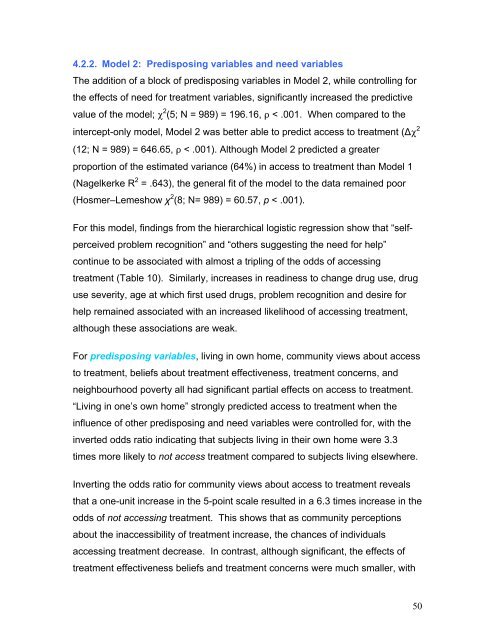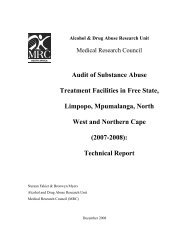Access to substance abuse treatment in the Cape Town metropole ...
Access to substance abuse treatment in the Cape Town metropole ...
Access to substance abuse treatment in the Cape Town metropole ...
Create successful ePaper yourself
Turn your PDF publications into a flip-book with our unique Google optimized e-Paper software.
4.2.2. Model 2: Predispos<strong>in</strong>g variables and need variablesThe addition of a block of predispos<strong>in</strong>g variables <strong>in</strong> Model 2, while controll<strong>in</strong>g for<strong>the</strong> effects of need for <strong>treatment</strong> variables, significantly <strong>in</strong>creased <strong>the</strong> predictivevalue of <strong>the</strong> model; P 2 (5; N = 989) = 196.16, D < .001. When compared <strong>to</strong> <strong>the</strong><strong>in</strong>tercept-only model, Model 2 was better able <strong>to</strong> predict access <strong>to</strong> <strong>treatment</strong> (ΔP 2(12; N = 989) = 646.65, D < .001). Although Model 2 predicted a greaterproportion of <strong>the</strong> estimated variance (64%) <strong>in</strong> access <strong>to</strong> <strong>treatment</strong> than Model 1(Nagelkerke R 2 = .643), <strong>the</strong> general fit of <strong>the</strong> model <strong>to</strong> <strong>the</strong> data rema<strong>in</strong>ed poor(Hosmer–Lemeshow χ 2 (8; N= 989) = 60.57, p < .001).For this model, f<strong>in</strong>d<strong>in</strong>gs from <strong>the</strong> hierarchical logistic regression show that “selfperceivedproblem recognition” and “o<strong>the</strong>rs suggest<strong>in</strong>g <strong>the</strong> need for help”cont<strong>in</strong>ue <strong>to</strong> be associated with almost a tripl<strong>in</strong>g of <strong>the</strong> odds of access<strong>in</strong>g<strong>treatment</strong> (Table 10). Similarly, <strong>in</strong>creases <strong>in</strong> read<strong>in</strong>ess <strong>to</strong> change drug use, druguse severity, age at which first used drugs, problem recognition and desire forhelp rema<strong>in</strong>ed associated with an <strong>in</strong>creased likelihood of access<strong>in</strong>g <strong>treatment</strong>,although <strong>the</strong>se associations are weak.For predispos<strong>in</strong>g variables, liv<strong>in</strong>g <strong>in</strong> own home, community views about access<strong>to</strong> <strong>treatment</strong>, beliefs about <strong>treatment</strong> effectiveness, <strong>treatment</strong> concerns, andneighbourhood poverty all had significant partial effects on access <strong>to</strong> <strong>treatment</strong>.“Liv<strong>in</strong>g <strong>in</strong> one’s own home” strongly predicted access <strong>to</strong> <strong>treatment</strong> when <strong>the</strong><strong>in</strong>fluence of o<strong>the</strong>r predispos<strong>in</strong>g and need variables were controlled for, with <strong>the</strong><strong>in</strong>verted odds ratio <strong>in</strong>dicat<strong>in</strong>g that subjects liv<strong>in</strong>g <strong>in</strong> <strong>the</strong>ir own home were 3.3times more likely <strong>to</strong> not access <strong>treatment</strong> compared <strong>to</strong> subjects liv<strong>in</strong>g elsewhere.Invert<strong>in</strong>g <strong>the</strong> odds ratio for community views about access <strong>to</strong> <strong>treatment</strong> revealsthat a one-unit <strong>in</strong>crease <strong>in</strong> <strong>the</strong> 5-po<strong>in</strong>t scale resulted <strong>in</strong> a 6.3 times <strong>in</strong>crease <strong>in</strong> <strong>the</strong>odds of not access<strong>in</strong>g <strong>treatment</strong>. This shows that as community perceptionsabout <strong>the</strong> <strong>in</strong>accessibility of <strong>treatment</strong> <strong>in</strong>crease, <strong>the</strong> chances of <strong>in</strong>dividualsaccess<strong>in</strong>g <strong>treatment</strong> decrease. In contrast, although significant, <strong>the</strong> effects of<strong>treatment</strong> effectiveness beliefs and <strong>treatment</strong> concerns were much smaller, with50
















